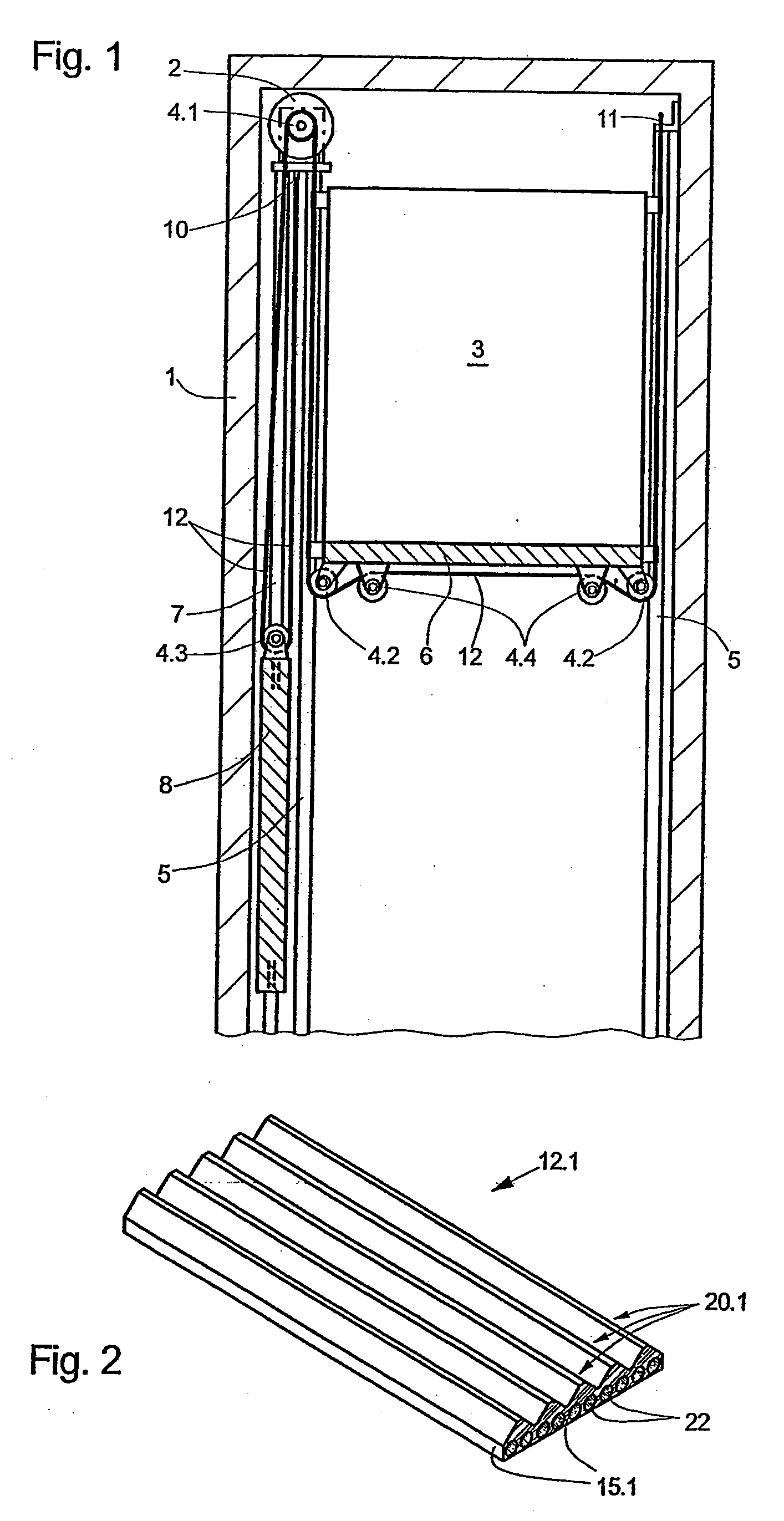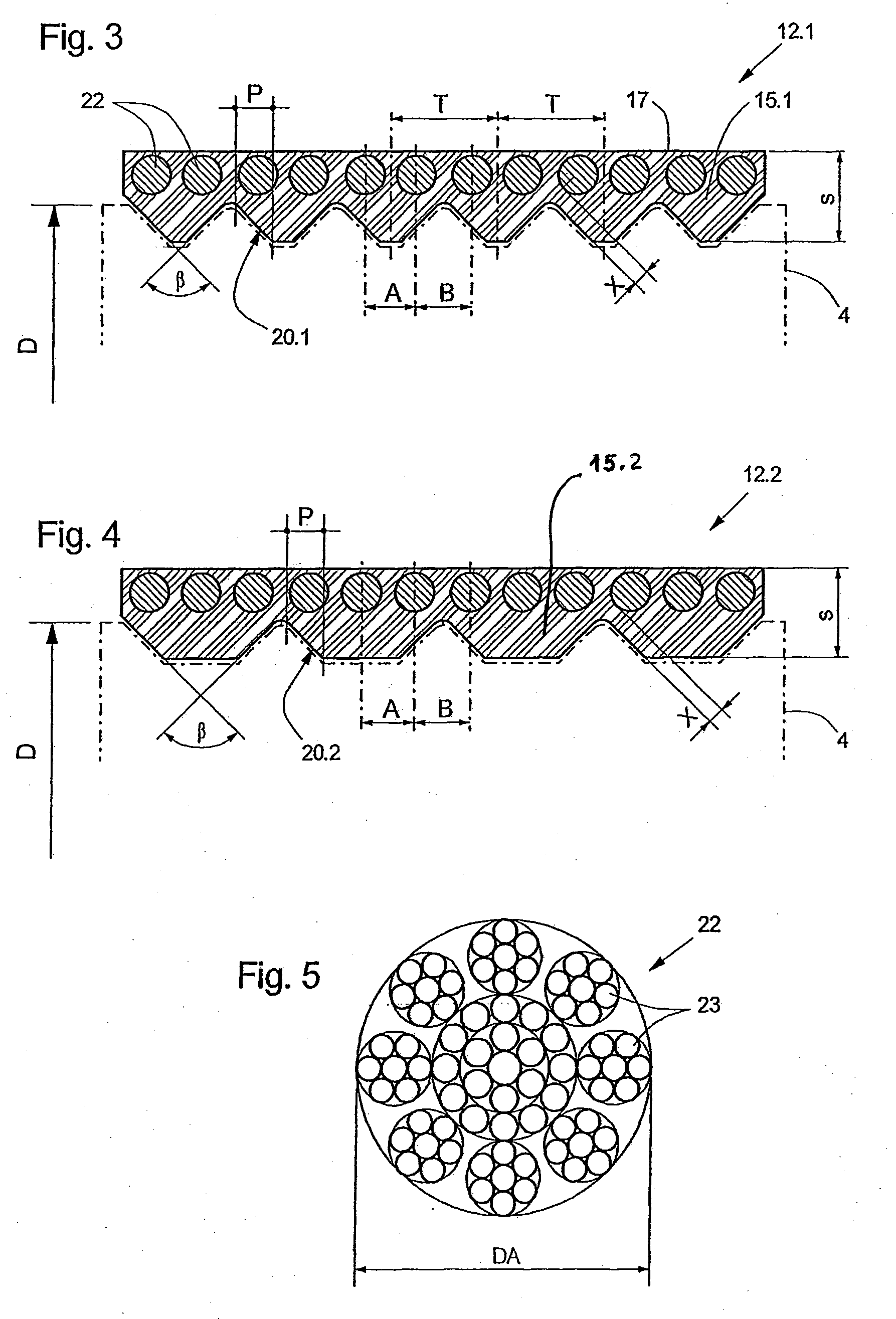[0009]Pursuant to this task, one aspect of the present invention resides in an elevator installation having a support means of flat belt form which has at least on a running surface facing the drive pulley several ribs extending parallel in the belt longitudinal direction, wherein at least two tensile carriers oriented in the belt longitudinal direction are present per rib and the sum of the cross-sectional areas of all tensile carriers amounts to at least 25%, preferably 30% to 40%, of the total cross-sectional area of the support means. For ascertaining the total cross-sectional area of the tensile carriers, the cross-section defined by the outer
diameter thereof is to be taken into account.
[0010]Through the distribution of the load to two tensile carriers (with the requisite cross-section) per rib it is achieved that the tensile means when the support means runs over belt pulleys with small diameters are exposed to smaller alternating bending stresses than if a single tensile carrier with correspondingly larger diameter were used per rib. With the indicated relationship between the sum of the cross-sectional areas of all tensile carriers and the cross-sectional area of the support means there is defined a support means which has optimally small dimensions and material quantities. The optimum small dimensions also have the consequence of correspondingly small alternating bending stresses in the material of the belt body. Materials (rubber, lastomer) can therefore be selected for production of the belt body which have a lower permissible bending stress, but tolerate higher area pressures between tensile carriers and belt body.
[0011]According to a preferred refinement of the invention there are used in the support means tensile carriers with a substantially round cross-section, the outer diameter of which amounts to at least 30%, preferably 35% to 40%, of the rib spacing. As rib spacing there is to be understood the spacing between adjacent ribs of a support means, which is usually the same between all ribs of a specific support means. In the case of a support means constructed in accordance with this rule it is ensured that the forces which are to be transmitted by the tensile carriers via the belt body to a drive pulley or a deflecting roller are optimally distributed in the belt body and the area pressures arising between tensile carriers and belt body are optimally small. The risk is thereby minimised that a loaded tensile carrier cuts through the belt body.
[0012]Advantageously the ribs have a wedge-shaped cross-section with a flank angle of 60° to 120°, wherein the range of 80° to 100° is to be preferred. The angle present between the two side surfaces (flank) of a wedge-shaped rib is termed flank angle. With flank angles of 60° to 120° it is ensured on the one hand that when the support means runs over belt pulleys no jamming between the ribs and the grooves, which are formed to be complementary thereto, of the belt pulleys arises. Running noises as also excitation of vibrations of the wedge-ribbed belt are thereby reduced. On the other hand, with such flank angles a sufficient guidance of the support means on the belt pulleys can be achieved, which prevents the
lateral displacement of the support means relative to the belt pulleys.
[0014]Optimally small dimensions and low weight of the support means are achievable if the minimum spacing of the outer contour of a tensile carrier from a surface of a rib amounts to at most 20% of the
total thickness of the support means. The
total thickness of the belt body with the grooves is to be understood as
total thickness.
[0015]According to a preferred refinement of the invention the tensile carriers associated with a rib are so arranged that a respective outer tensile carrier lies substantially in the region of the perpendicular projection of each flank of the wedge-shaped rib. A projection oriented perpendicularly to the plane of the flat side of the support means is termed perpendicular projection and by “substantially” there is to be understood that at least 90% of the cross-sectional area of the respective tensile carrier lies within the said projection.
[0015]According to a preferred refinement of the invention the tensile carriers associated with a rib are so arranged that a respective outer tensile carrier lies substantially in the region of the perpendicular projection of each flank of the wedge-shaped rib. A projection oriented perpendicularly to the plane of the flat side of the support means is termed perpendicular projection and by “substantially” there is to be understood that at least 90% of the cross-sectional area of the respective tensile carrier lies within the said projection.
[0017]With the two arrangements, defined in the foregoing, of the tensile carriers in the flank region it is guaranteed that when running around a belt pulley no tensile carrier has to be supported by that point of the belt body which has the deepest
notching formed by the grooves
lying between the ribs.
[0018]In order to obtain support means which for a given tensile loading have a smallest possible longitudinal stretching, tensile carriers of steel wire cables are used. Steel wire cables are less stretched, for the same loading, than, for example, tensile carriers with the same cross-section of conventional synthetic fibres.
 Login to View More
Login to View More 


